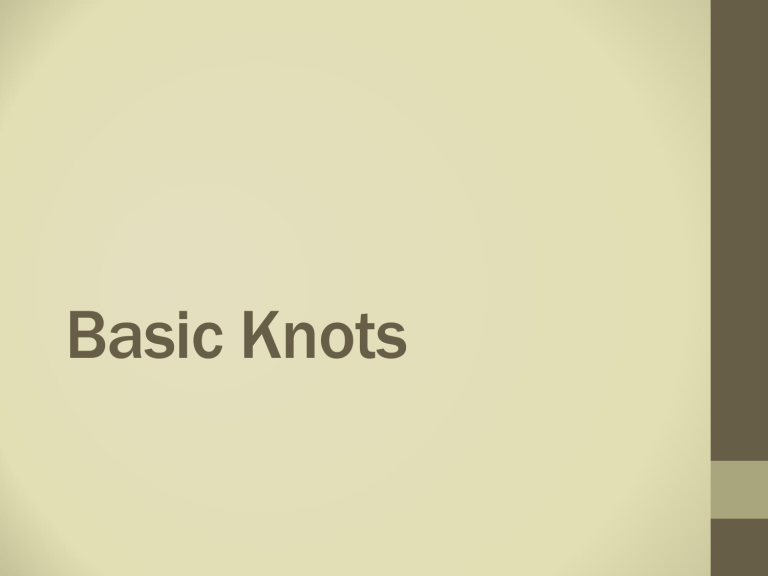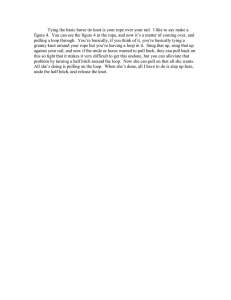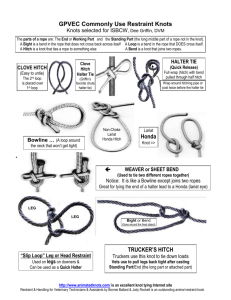BASIC KNOTS

Basic Knots
Terminology
• Standing End – any part of rope that is not the working end
• Running End – working end of rope
• Bight – bend in rope (non crossing)
• Overhand Loop – running end on top
• Underhand Loop – running end on bottom
• Turn – loop around object
Terminology
Overhand Knot
• Procedure
1.
Form an overhand loop
2.
Insert one end of the rope into the loop.
3.
Tighten up the knot
• Uses
• To stop the end of the rope from fraying
• As a stopper knot (prevent another knot from coming untied)
• A series of spaced overhand knots can slow down the pace of a man going down a slope with the aid of a long rope
• Ancient Inca accounting and language system (cipher) (Quipi)
OverhandKnot
Square Knot (Reef Knot)
• Procedure
1.
Hold each end of the knots with both hands
2.
Form an overhand knot or a loop by placing the right end over the left – the right end entering from the outer part of the knot going towards the person
3.
Form a bight, this time, left over right
• Uses
• To close the knot in lashing when making gadgets
• Tie shoe string, gifts, ribbons, bolts, etc
• Bind packages, firewood, etc. together
• To close triangular bandage in first aid
Square Knot
Bowline
• Procedure
1.
Start by forming an overhand loop on the standing part which is large enough for its purposes.
2.
Take a free end up through the eye, around the standing part, and right back where it came from.
• Uses
• Create a non-closing loop
• To save a drowning person
• To tie animals
Bowline
Two Half Hitches
• Procedure
1.
Begin by forming a clockwise loop around the pole, with the working end of the rope on top. Bring the working end through the loop. At this point, you have an overhand knot around the pole.
2.
Bring the working end down and to the left. Loop it under the standing end. Pull the working end through the loop just formed, tighten, and slide the knot along the standing end up to the post.
3.
A correctly tied two half hitches resembles a clove hitch tied around the standing end of the line, not a cow hitch.
• Uses
• Securing a rope to a fixed object
Two Half Hitches
Taut Line Hitch
• Procedure
• Make a turn around a post or other object several feet from the free end.
• Coil the free end twice around the standing line working back toward the post.
• Make one additional coil around the standing line on the outside of the coils just made.
• Tighten the knot and slide it on the standing line to adjust tension.
Taut Line Hitch
• Uses
• Tie tent guy lines
• Tie dining fly guy lines
• Create adjustable length tie out
• Midshipman’s hitch more secure
Taut Line Hitch
Clove Hitch
• Method A Procedure
1.
Hold each end with both hands.
2.
Form a loop with the right end towards you and the left end away from you.
3.
Let the two loops meet at the center. Insert finger between the loops. An X is formed when the two ends meet at the center.
• Method B Procedure
1.
Take one end of the rope in your right hand. With the left, hold rest of rope across front of pole.
2.
Pass end of rope around in back of pole.
3.
Bring it around to front of pole. Cross it over long part making an X. Hold X with left thumb and forefinger.
Clove Hitch (cont.)
• Method B Procedure
4.
Pass rope to the right again, wrapping it around pole below first turn.
5.
Push rope end under X, going from left to right so that it comes out between the two turns around pole.
6.
Pull short end to the right, long end to the left.
7.
Untie it by pushing both ends towards the center.
• Uses
• To start lashing when making gadgets.
• Tie the clothesline.
• Attach a rope to a tree, pole hands or fingers.
• Bind objects together.
• Tie rope on objects – the rope to be used for mountain climbing, to secure against a tree in rescuing a drowning person.
Clove Hitch
Timber Hitch
• Procedure
1.
Make a half hitch.
2.
Entangle the working part of the rope with half hitch.
• Uses
• To tie a rope to a log or pole that needs to be pulled.
• To start diagonal lashing.




